Is It Safe To Freeze Food In Plastic Containers?
Sure, they are extremely convenient, but do consider their impact on your health.
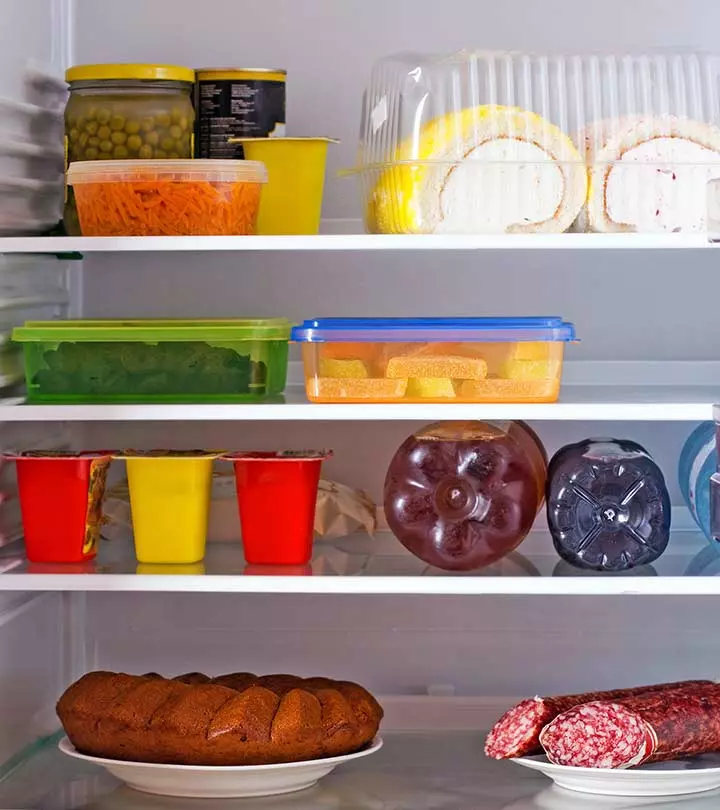
Image: Shutterstock
Our hectic lives often force us to stock up on foods in the refrigerator. While this may save time, how safe is it to freeze food in plastic containers? Plastic is becoming a go-to material for multiple purposes. Its versatility is making it a part of our daily lives. However, there are many queries about the use of plastic as a packaging material for packaging or storing perishable food. Being aware of the safety of freezing food in plastic containers is crucial, as it can impact both your health and food quality. In this article, we aim to clarify these concerns. Keep reading to understand if plastic is safe for food storage and any safer alternatives to plastic that you may consider.
In This Article
Types Of Plastics
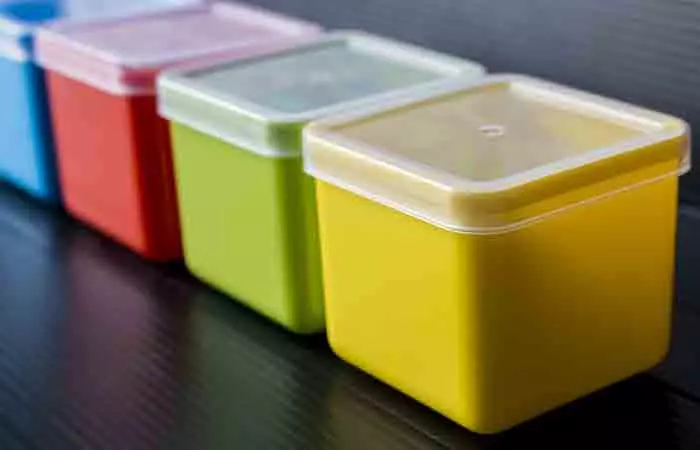
Generally, plastic food containers are made of different kinds of plastics. Usually, the triangle mark contains a ‘resin identification number’ inside it. This number actually denotes the degree of recyclability of the plastic, and the triangle determines if the plastic is recyclable or not.
Safe Plastics

Some plastics are preferred to others when it comes to storage and packaging of food. Generally, safe plastics include materials like:
1. Polyethylene Terephthalate (PET Or PETE):
This is the most popular form of plastic container in the market. Used to store all kinds of foods and beverages like water, juice, mayonnaise etc., PET jars can be reused once they are cleaned with soap water. However, a word of caution: research shows that washing PET bottles over and over again can result in the plastic’s toxic and carcinogenic chemicals getting into the stored food or water, so it might not be suitable for long-term storage. Discard your PET jar if it gets cracked or appears cloudy.
2. High-Density Polyethylene (HDPE):
Another safe plastic used to make milk jugs and water bottles that can handle cold temperatures, high-density polyethylene does not release toxic or carcinogenic chemicals into food or water and is accepted by most recycling companies.
3. Low-Density Polyethylene (LDPE):
These types of plastics don’t release chemicals into stored food, but they aren’t readily accepted by recyclers.
LDPE plastics are usually used to make sealable sandwich bags, plastic cling-wrap, and squeezable condiment bottles.
4. Polypropylene (PP):
This type of plastic container does not release any chemicals into food or water, but not all organizations recycle polypropylene. It is primarily used to make yogurt and other reusable airtight snack containers.

5. Bio-Plastic:
This plastic is usually used to make plastic cups, picnic plates and utensils. It is created using renewable sources like corn, potatoes, sugarcane and other starchy foods.
 Did You Know?
Did You Know?Unsafe Plastics
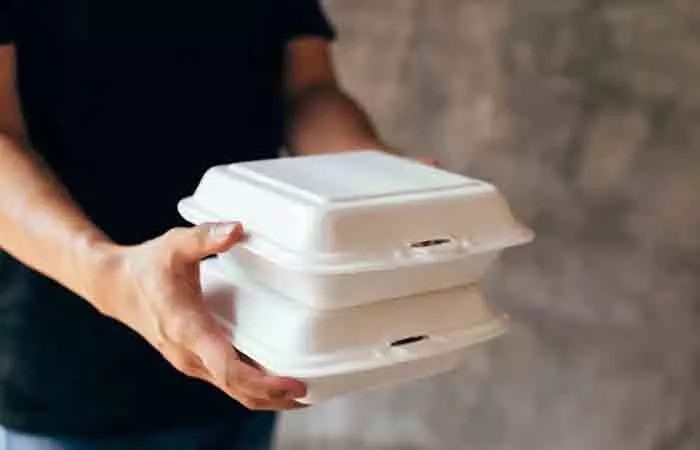
These plastics are quite dangerous and can cause chronic diseases. You may find plastic containers in the market labeled as microwave or freezer-safe, but they can still release toxic chemicals under certain temperatures. You need to be aware of these risks and be able to identify unsafe plastics, such as:
1. Polyvinyl Chloride (PVC):
This type of plastic is regularly used to make cling-wraps and other plastic containers. PVC releases dioxins that are classified as human carcinogens. PVC also contains phthalates that can lead to improper hormonal function, and can even cause hormonal damage.
2. Polystyrene (PS):
This plastic is used to make cups, cartons and take-out containers. The popular white foam cup is made up of polystyrene, whose manufacture releases carcinogenic and toxic chemicals that can lead to many health conditions.
3. Polycarbonate (PC):
Usually used to make water cooler bottles and baby bottles, polycarbonate contains bisphenol A, which has known hormone-disrupting qualities.
Key Takeaways
- Plastic containers made of natural ingredients, such as potatoes or corn are considered safe for use for food preservation.
- Containers made of polystyrene or polycarbonate may cause hormonal imbalance. This is also true of ice trays.
- Pyrex glass or moisture-proof containers are suitable for storing frozen food.
- Plastic containers are considered unsuitable for reheating, cooking, freezing, and storing food.
Freezing Food
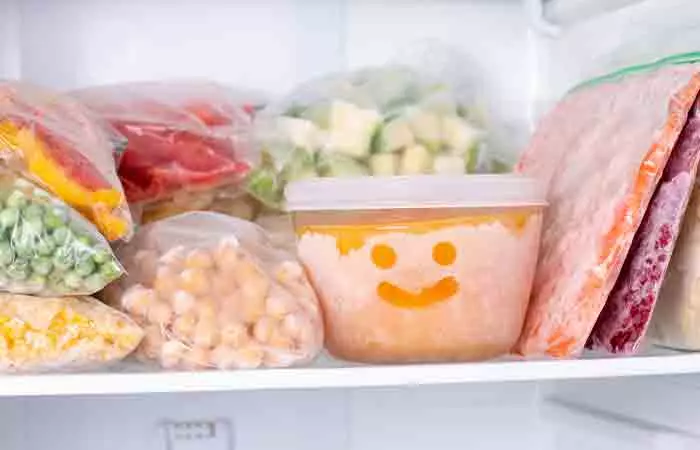
Usually, the best plastic container to store frozen food is a moisture-vapor-resistant plastic container with a lid. These plastics are quite safe and can be used for years. On the other hand, you can consider using Pyrex glass containers with lids to freeze, microwave and store food. These are readily available, and users claim that they pose no threats, unlike the toxic and carcinogenic chemicals used to make plastic. However, more research is needed in this area.
Although freezing food in plastic containers is generally allowed, there are a few things one needs to consider before choosing these containers. Check out the section below to know more.
Choosing Containers To Freeze Food
Selecting suitable containers for freezing food is essential to maintain freshness and prevent freezer burn. Opt for airtight, freezer-safe containers made of materials like BPA-free plastic. For those who may not know, BPA, or Bisphenol A, is a chemical compound commonly used in the production of plastics and resins. It’s found in products like water bottles, food containers, and the lining of metal cans. A study has been conducted on the widespread presence of BPA in various environments and human exposure through different sources. This study explains that BPA is found in the air, water, and soil, contributing to human exposure in three main ways- through environmental contamination, direct contact at work, and food consumption. Food packaging materials, especially plastic containers and canned food linings, are a significant source of BPA exposure. As BPA is absorbed into food, it poses serious risks to human health when consumed, including potential effects on the brain, behavior, and prostate gland in fetuses, infants, and young children (7).
Ensure the containers have minimal headspace to reduce the introduction of air, which can lead to freezer burn. Choose containers with a tight seal to prevent odors and flavors from permeating the food. Consider using containers with the flexibility to expand, accommodating the food as it freezes. Label containers with the date and contents for easy identification. A thoughtful selection of freezer containers ensures preserved quality, taste, and convenience when thawing and consuming frozen foods.
 Quick Tip
Quick TipAlthough storing food in plastic containers appears convenient, know how safe it is in the section below.
Is It Safe To Freeze Food In Plastic Containers?
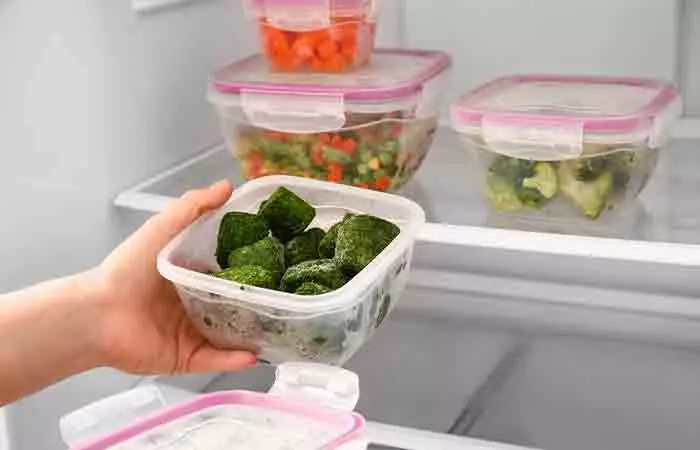
You have looked at the different safe and unsafe plastics, and what kinds of plastics you can effectively use to freeze food. Plastic has many domestic and industrial uses, but it is not a good material to cook, reheat, freeze and store food in, even if the plastic is marked microwave safe or temperature resistant. So the next time you are about to freeze food in plastic, consider wrapping it in aluminum foil instead of cling–wrap for food safety.
The practice of freezing food itself has a range of benefits that make it a cost-effective way to preserve meals and ingredients. One of the primary advantages is that it extends the shelf life of perishable items and keeps them fresh for longer periods (1). Additionally, frozen foods retain most of their vitamins and minerals, and sometimes may even have better nutrition than fresh foods (2). It also helps reduce food waste and saves a lot of time.
The common knowledge about freezing foods and its benefits is limited and engulfed in many myths. In the next section, we debunk a few of them.
Myths And Facts About Freezing Food
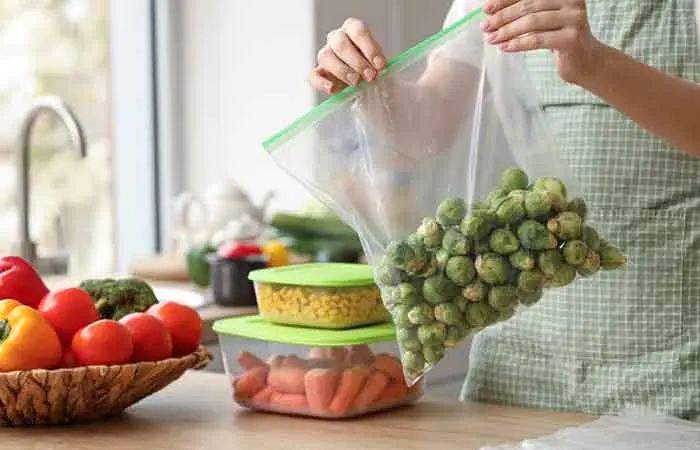
There are widespread myths about freezing food and how it impacts food quality. It is important to differentiate them from facts to make the most of this process.
Myth 1: Freezing Food Reduces Its Nutritional Value
Fact:
Freezing preserves nutrients, especially when done quickly.
One widespread myth is that frozen food is nutritionally inferior to fresh food. However, freezing preserves vitamins and minerals, and can even enhance their nutritional content occasionally (2).
Myth 2: Frozen Foods Contain A Lot Of Preservatives
Fact:
Freezing is a natural preservation method and does not require additives.
Some people believe frozen foods must contain preservatives to stay edible. But, in reality, freezing itself is an entirely natural preservation technique (3). When done correctly, freezing simply halts bacterial growth by bringing temperatures low enough to make the environment unlivable for microorganisms.
Myth 3: Frozen Food Lasts Indefinitely
Fact:
Freezing can keep food safe for a long time, but quality declines over time.
While frozen food can be preserved for a long time at 0°F (-18°C) or below, the quality does not remain at its best forever (4). The quality of their flavor, aroma, and texture continues to deteriorate. Most frozen foods should be consumed within a certain timeframe. Freezer burn, a common issue with long-frozen meat, can dry it out and negatively affect appearance and nutrient content (5).
Myth 4: Freezing Kills Bacteria And Parasites
Fact:
Freezing only inactivates bacteria. It does not kill them.
A common misconception is that freezing kills harmful bacteria and parasites. In reality, freezing stops the growth of bacteria but does not eliminate most of them (4).
Myth 5: Refreezing Thawed Food Is Unsafe
Fact:
Refreezing thawed food is safe if it is thawed properly and kept cold.
While it is true that food quality may suffer with repeated freezing and thawing, refreezing is safe if the food has been thawed in the refrigerator and has not reached room temperature (6).
Gaining clarity on these myths can ensure you freeze your food correctly to them fresh, tasty, and nutritious.
And please tell us about your methods of storing food. Leave a comment below!
Infographic: How To Store Food Safely In The Freezer
Our fast-paced lifestyles force us to store leftover or pre-prepared food in the freezer. We usually have our foods wrapped in cling film or plastic boxes thanks to their ease of use. But how safe is plastic for storing food? Are there any alternatives? Check out the infographic below for a quick glance at the types of unsafe plastics and the better alternatives you can replace these with.
Some thing wrong with infographic shortcode. please verify shortcode syntax
Freezing food in plastic has become very common nowadays because of hectic work schedules, which generally demand stocking up of food. However, many are worried about plastic usage for food freezing or storing. Plastics are divided into safe plastics and unsafe plastics. Safe plastics are generally preferred over unsafe ones for food packaging. However, compared to other materials like glass, the plastic weighs more on the unsafe side even after labeling safe. Hence, minimize food freezing in plastic and consider wrapping it in an aluminum foil or freezing it in a glass container with a lid.
Frequently Asked Questions
Can I reuse plastic containers for freezing food?
While you can reuse some plastic containers, ensure they are designed for freezing and check for any signs of wear or damage. Containers that are cracked or cloudy may not provide safe storage.
What is the best container to freeze food in?
Freezer-safe glass containers are the best option for freezing food in, as there is no risk of chemical leach. However, certain plastic containers also work just as well.
Are Rubbermaid plastic containers freezer safe?
Yes, Rubbermaid plastic containers are designed from BPA-free plastic and crafted to be freezer-safe.
Is it safe to freeze food in Tupperware?
Yes, Tupperware are airtight and freezer-safe containers made of polypropylene and low-density polyethylene plastics, making it safe for daily use
Does freezing plastic release toxins?
No, anecdotal evidence suggests that there is no harm in freezing plastics. It works against the chemicals as they do not easily diffuse in cold temperatures.
How long can you keep frozen food in plastic bags?
While different foods have different shelf lives, most food can be stored for up to 1-2 months in the freezer.
Illustration: Is It Safe To Freeze Food In Plastic Containers?
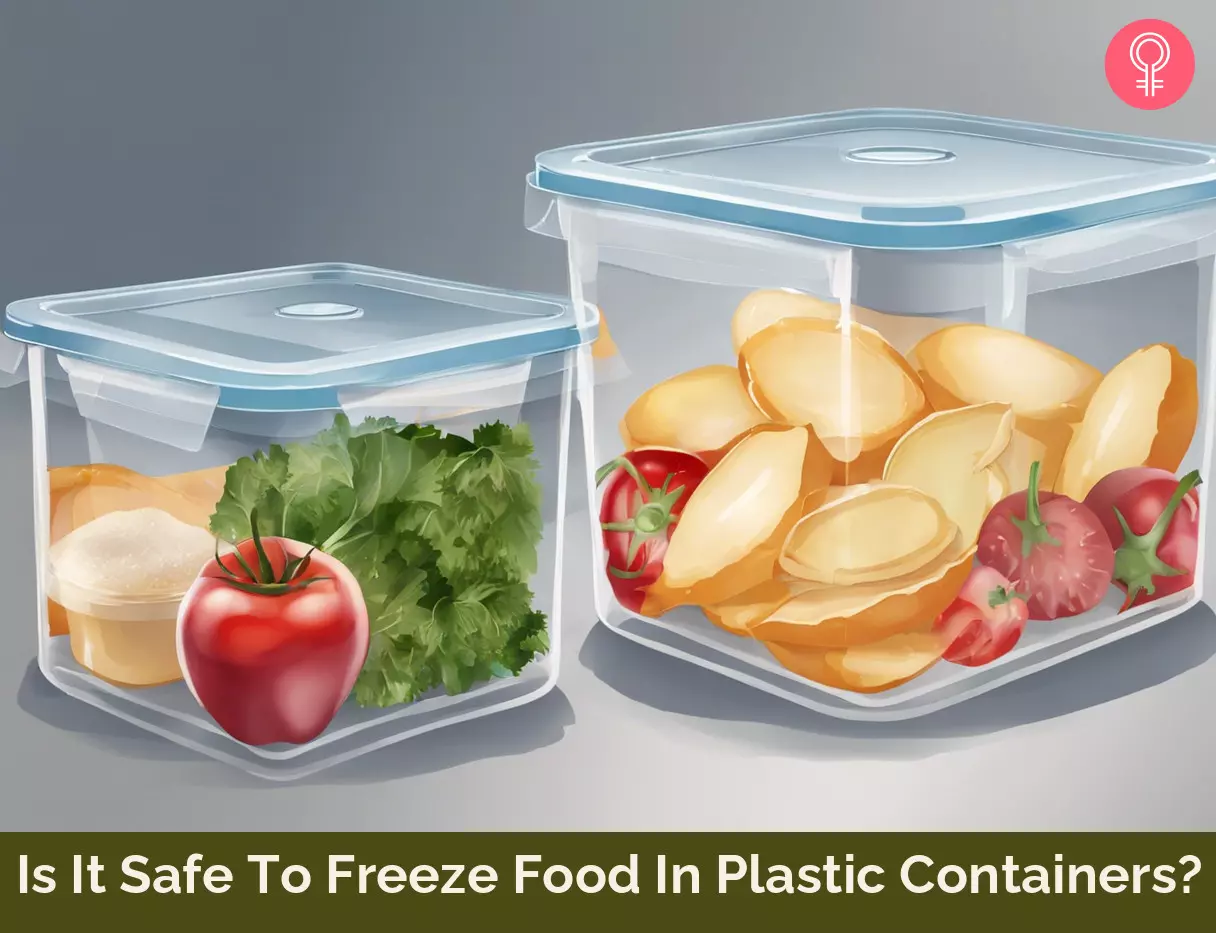
Image: Stable Diffusion/StyleCraze Design Team
When it comes to storing food, caution is key – especially when freezing it. Watch this video for essential tips on safely freezing food in plastic containers.
References
Articles on StyleCraze are backed by verified information from peer-reviewed and academic research papers, reputed organizations, research institutions, and medical associations to ensure accuracy and relevance. Read our editorial policy to learn more.
- Effects of Deep Freezing Temperature for Long-term Storage on Quality Characteristics and Freshness
https://pmc.ncbi.nlm.nih.gov/articles/PMC6238029/ - Vitamin retention in eight fruits and vegetables: a comparison of refrigerated and frozen storage
https://pubmed.ncbi.nlm.nih.gov/25526594/ - Why frozen fruit and veggies may be better for you than fresh
https://www.ncbi.nlm.nih.gov/search/research-news/4060/# - Freezing: an underutilized food safety technology
https://pubmed.ncbi.nlm.nih.gov/14698095/ - Are You Storing Food Safely?
https://www.fda.gov/consumers/consumer-updates/are-you-storing-food-safely - Impact of Freezing on the Microbiological Quality and Physical Characteristics
https://pmc.ncbi.nlm.nih.gov/articles/PMC8698174/ - An insight into bisphenol A, food exposure and its adverse effects on health: A review
https://pmc.ncbi.nlm.nih.gov/articles/PMC9671506/
Read full bio of Elizabeth Brown
Read full bio of Jyotsana Rao
Read full bio of Madhumati Chowdhury
Read full bio of Joyce Joyson






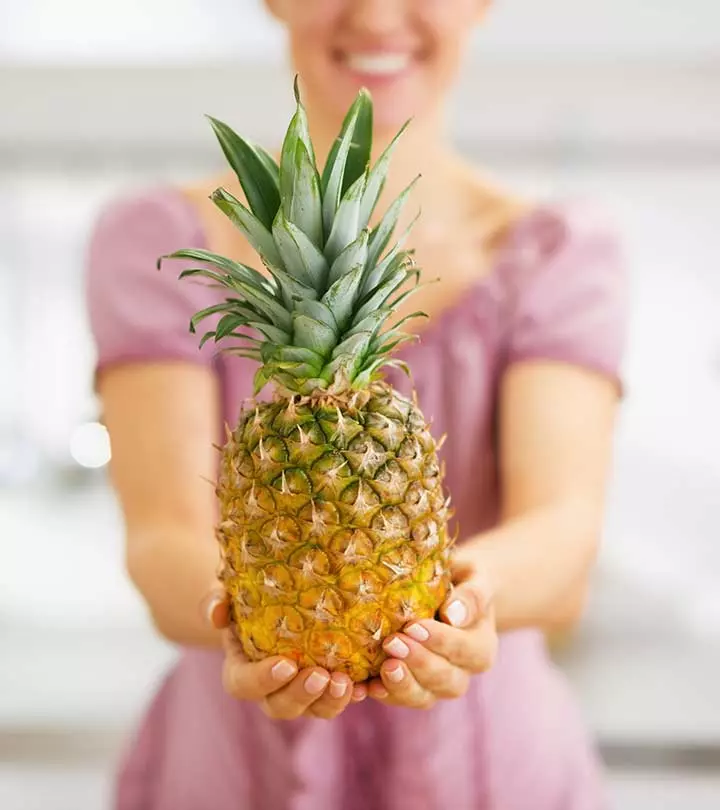


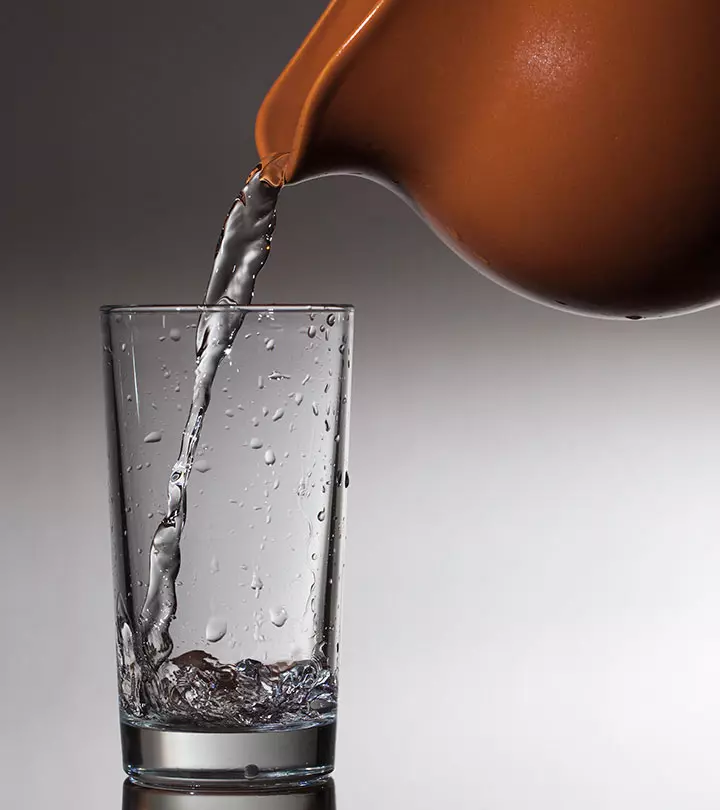

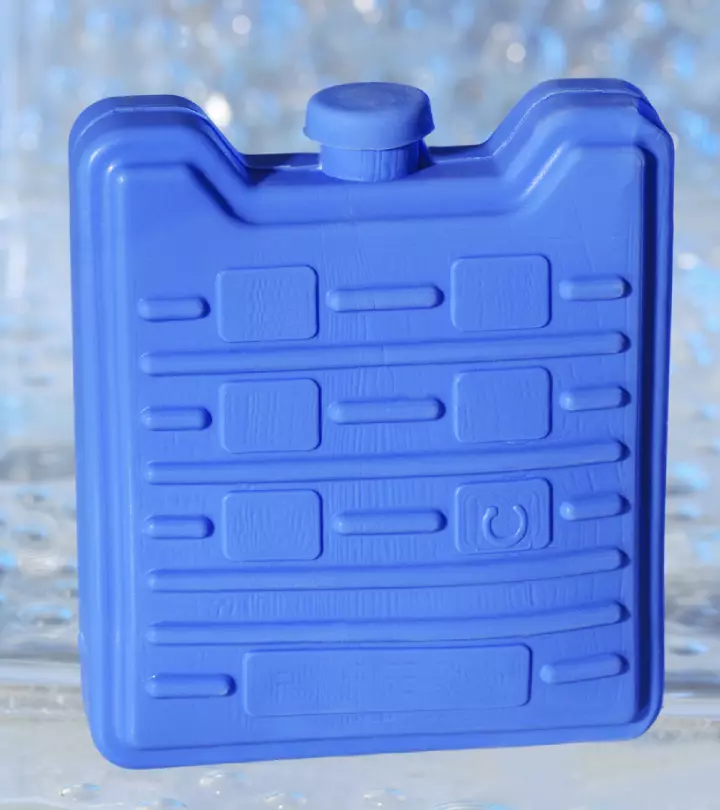

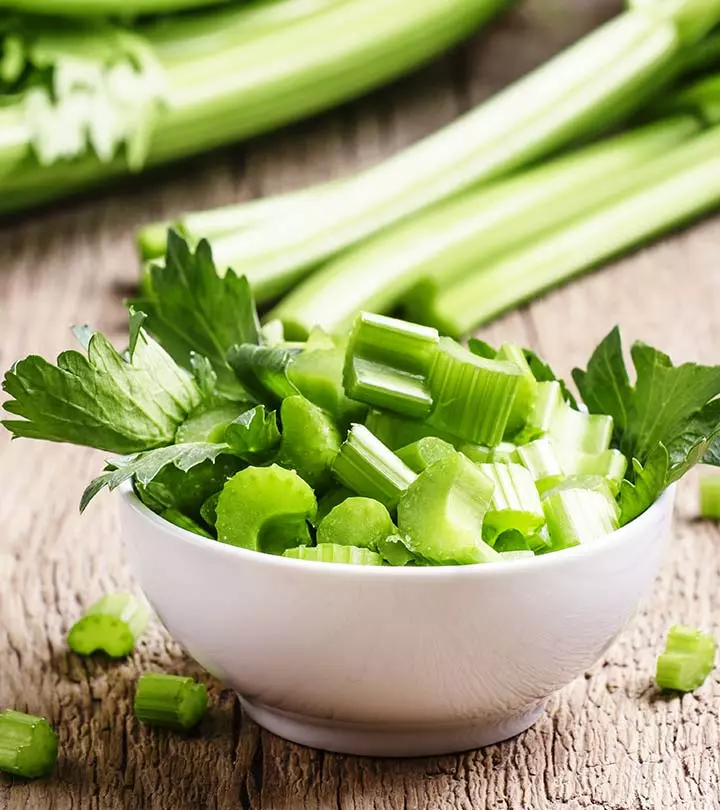
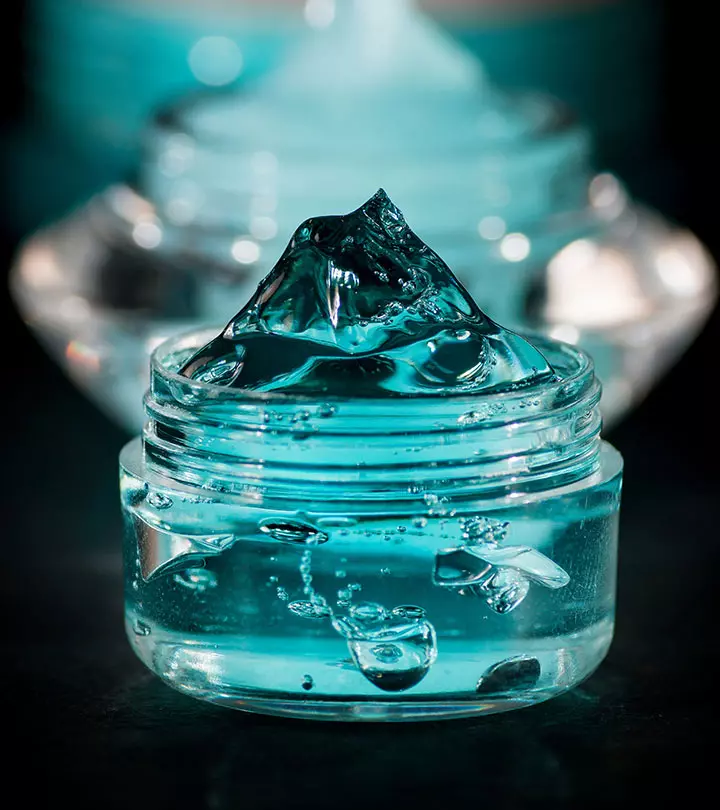









Community Experiences
Join the conversation and become a part of our empowering community! Share your stories, experiences, and insights to connect with other beauty, lifestyle, and health enthusiasts.